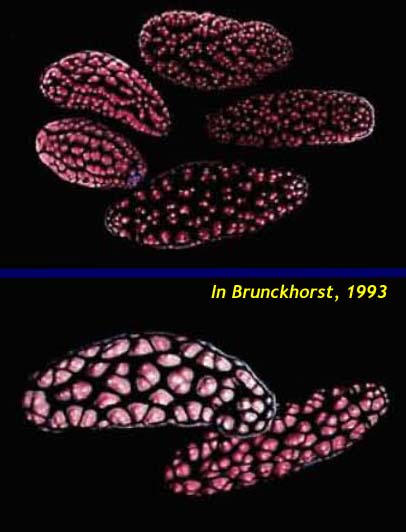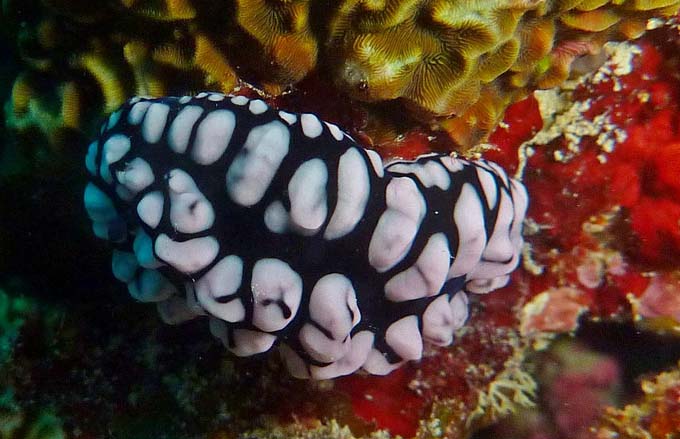This species has been observed on Reunion and Mauritius Islands
Remarks :
Synonymous (according worms) :
- Fryeria variabilis Collingwood, 1881 - Phyllidia spectabilis Collingwood, 1881
- Phyllidia albonigra Quoy & gaimard, 1832 - Phyllidia verrucosa van hasselt, 1824
- Phyllidia melanocera Yonow, 1986 - Phyllidia fumata , Rüppell & Leuckart, 1830
- Phyllidia nobilis Bergh, 1869 - Phyllidiella nobilis (bergh, 1869)
- Phyllidia pustulosa Cuvier, 1804
- Phyllidia rotunda eliot, 1904
| Bibliographic data : Other external morphology characteristics
|
 |
Similar species
Phyllidiella pustulosa has similarities in appearance to Phylidiella annulata , Phylidiella zeylanica, Phylidiella granulata, Phyllidopsis burni, Phyllidiella nigra and Phyllidiella cooraburrama
But Phylidiella annulata differs in having many pink rings with low angular tubercles, in lacking a pale edge to the mantle and in the possession of 17-20 lamellae on each rhinophoral clavus (specimens greater than 23 mm).
But Phylidiella zeylanica has pink compound tubercles which are coalesced into longitudinal ridges ( not clusters) and black longitudinal lines.
But Phylidiella granulata has three median groups of tubercles but differs from P. pustulosa in that the tubercles are acute, multi-compound and white with grey bases, a granular grey mantle edge and 17-20 lamellae on each rhinophoral clavus.
But Phyllidopsis burni has multiple tips tubercles.
But Phyllidiella nigra is black at the mantle edge and the tubercles are usually single, quite high and evenly distributed (not clustered) over the dorsum.
But Phyllidiella cooraburrama has usually single, tall, multicompound and quite pointed tubercles
References :
Bill Rudman Seaslug site : Sea Slug Forum : Phyllidiella pustulosa
Publications :
Brunckhorst,D.J. (1993) The systematics and phylogeny of Phyllidiid Nudibranchs (Doridoidea). Records of the Australian Museum, Supplement 16 : 1-107.
Valdés, Á. (2001). Nudibranches Phyllidiidae (Mollusca, Gastropoda) des eaux profondes du Sud-Ouest Pacifique = Deep-water phyllidiid nudibranchs (Gastropoda: Phyllidiidae) from the tropical south-west Pacific Ocean. in: Bouchet, P. et al. (Ed.) Tropical deep-sea benthos. Mémoires du Muséum national d'Histoire naturelle. Série A, Zoologie. 185: 331-368
Other photos of Phyllidiella pustulosa :
Florence Trentin Reunion, "Eboulis reef" at Saint Leu, 15m, 40 mm. Photo of the foot and underside of this animal, this specimen not dark grey medially, becomes lighter towards the margins as in the species description... But you can see the mantle margin edged in pale pink .
|
 |
.jpg) |
Jean Marie Gradot Reunion, La Saline lagoon, less 1 m, 18 April 2015 A specimen partially eaten... |
Pierre Périès Mauritius, Trou aux Biches, 4 June 2016
|
 |
If you have taken a photo of this species in South West Indian Ocean, please Contact us..
